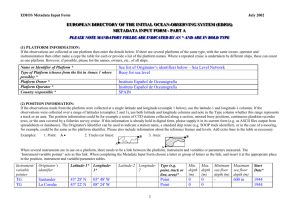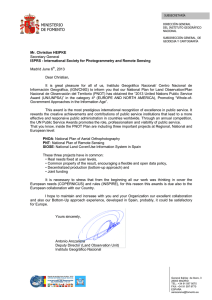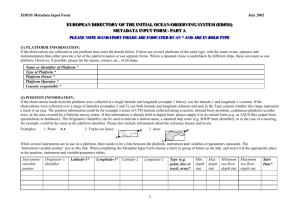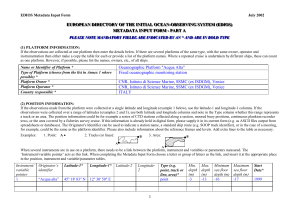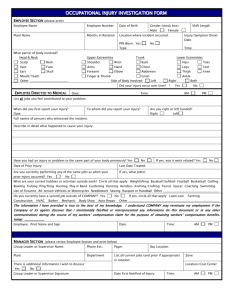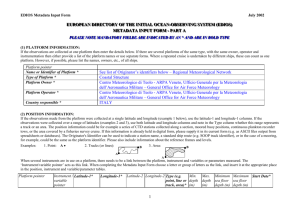Web-site for access to real
advertisement
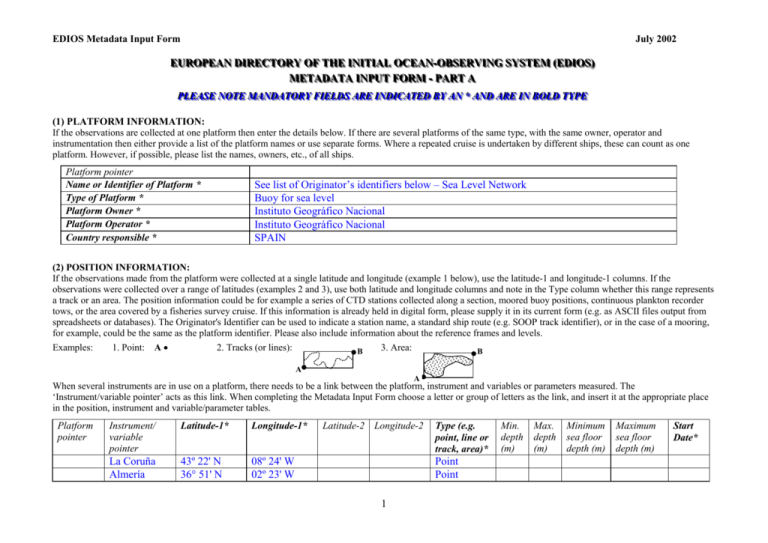
EDIOS Metadata Input Form July 2002 E EU UR RO OPPE EA AN ND DIIR RE EC CT TO OR RY YO OFF T TH HE E IIN NIIT TIIA AL LO OC CE EA AN N--O OB BSSE ER RV VIIN NG G SSY YSST TE EM M ((E ED DIIO OSS)) M ME ET TA AD DA AT TA A IIN NPPU UT T FFO OR RM M -- PPA AR RT TA A PPLLEEAASSEE N NO OTTEE M MAAN ND DAATTO ORRYY FFIIEELLD DSS AARREE IIN ND DIICCAATTEED D BBYY AAN N ** AAN ND D AARREE IIN N BBO OLLD D TTYYPPEE (1) PLATFORM INFORMATION: If the observations are collected at one platform then enter the details below. If there are several platforms of the same type, with the same owner, operator and instrumentation then either provide a list of the platform names or use separate forms. Where a repeated cruise is undertaken by different ships, these can count as one platform. However, if possible, please list the names, owners, etc., of all ships. Platform pointer Name or Identifier of Platform * Type of Platform * Platform Owner * Platform Operator * Country responsible * See list of Originator’s identifiers below – Sea Level Network Buoy for sea level Instituto Geográfico Nacional Instituto Geográfico Nacional SPAIN (2) POSITION INFORMATION: If the observations made from the platform were collected at a single latitude and longitude (example 1 below), use the latitude-1 and longitude-1 columns. If the observations were collected over a range of latitudes (examples 2 and 3), use both latitude and longitude columns and note in the Type column whether this range represents a track or an area. The position information could be for example a series of CTD stations collected along a section, moored buoy positions, continuous plankton recorder tows, or the area covered by a fisheries survey cruise. If this information is already held in digital form, please supply it in its current form (e.g. as ASCII files output from spreadsheets or databases). The Originator's Identifier can be used to indicate a station name, a standard ship route (e.g. SOOP track identifier), or in the case of a mooring, for example, could be the same as the platform identifier. Please also include information about the reference frames and levels. Examples: 1. Point: A 2. Tracks (or lines): B 3. Area: B A A When several instruments are in use on a platform, there needs to be a link between the platform, instrument and variables or parameters measured. The ‘Instrument/variable pointer’ acts as this link. When completing the Metadata Input Form choose a letter or group of letters as the link, and insert it at the appropriate place in the position, instrument and variable/parameter tables. Platform pointer Instrument/ variable pointer Latitude-1* Longitude-1* La Coruña Almería 43º 22' N 36° 51' N 08º 24' W 02º 23' W Latitude-2 Longitude-2 Type (e.g. point, line or track, area)* Point Point 1 Min. depth (m) Max. depth (m) Minimum sea floor depth (m) Maximum sea floor depth (m) Start Date* EDIOS Metadata Input Form Alicante (I-II) Sta. Cruz de Tenerife July 2002 38° 16' N 28º 28' 42'' N 00º 34' W 16º 14' 25'' W Point Point Geographic frame of reference (e.g. WGS84): Reference level for depths (e.g. relative to chart datum, mean sea level, instantaneous water surface, sea floor, etc.): (3) INSTRUMENT INFORMATION: Please supply information relating to the instruments used to make the measurements, or attach the information if it is available in digital or printed form. If many instruments are in use, add them in to the EDIOS_MIF_INST file. Instrument/variable pointer Instrument Type* Instrument Name* Manufacturer and model Manufacture date Description Technical characteristics Tide gauge Floating tide gauge, with digital output. The tide gauge network measures sea level heights, with floating sensors measuring at the piers inside of small buldinds. The data are transmitted to the IGN Data Centre by telephone line in delayed mode. The sea level measurements are referenced to local and global systems. Further relevant information Other attached equipment (4) VARIABLE/PARAMETER INFORMATION: List the variables or parameters measured (e.g. temperature, salinity, chlorophyll a, phytoplankton, dissolved oxygen, pH, particulate carbon, silicate, etc), including where possible, an estimate of their accuracy. Any standard real-time or delayed-mode validation schemes should also be noted. Instrument/ parameter pointer Variable/Parameter* Sea level Accuracy Real-time data validation? Delayed-mode validation? NO YES 2 Sampling frequency (e.g. 10 minute, hourly, daily, annually,3 hours before high water, etc.) EDIOS Metadata Input Form July 2002 (5) QUALITY MANAGEMENT SYSTEM Complete for each platform, group of platforms, instrument or group of instruments as appropriate Is there a Quality Management System (QMS) followed by the organisation responsible for the observations?* If yes, is the institution accredited or certified? * If yes, indicate accreditation scheme (e.g. ISO9000, QUASIMEME) Yes No Yes No GLOSS If no, please note which of the following quality assurance procedures are applied (or attach appropriate documentation) How frequently are sensors calibrated? Are sensors calibrated prior to and after the measurement period? Is calibration performed by the manufacturer or by the data generating institution? To what accuracy are the sensors calibrated? Are there sensor intercalibrations (regular or not)? Are there back-up sensors? For automatic recording stations: Frequency of comparative in situ measurements (for each variable). Is there an instant data validation based on neighbouring stations? Are data gaps filled by derived values (e.g. after multi-linear regression)? Are standard procedures applied for the processing of the (raw) data (e.g. removal of spikes, comparison with existing climatologies etc.)? Are there additional quality control checks, such as consistency checks, range of validity, date, geographical position (typical NODC control procedures)? In chemistry: Are there intercalibration exercises? Proficiency testing? Internal quality assurance procedures, e.g. control charts, blank analyses? Name E(uropean) N(orm,) NODC? Are the high quality data and the corresponding metadata safe-guarded in a YES, Spanish data bank of sea level data (RIMA) central data bank (NODC, WDC) Include details of any other relevant procedures in use 3 EDIOS Metadata Input Form (6) OBSERVING PROGRAMME INFORMATION Observing programme name (e.g. UK tide gauge network, UK MAWS (met. Buoy) network, CTD section, Swedish coastal monitoring stations)* IGN - Tide Gauge Network Description of programme The IGN - Tide Gauge Network is a component of RIMA, a national program for the Integration of sea level networks operating in Spain and maintained by Instituto Español de Oceanografía (IEO), Puertos del Estado (Clima Marítimo), Instituto Geográfico Nacional (IGN) and Instituto Hidrográfico de la Marina (IHM). National/International project name(s) (e.g. Argo, GODAE, MedGOOS) RIMA (Red Integrada de Mareógrafos) PROGRAMME STATUS: Please note future commitment to the observing programme, adding dates where appropriate * An active measurement programme with no planned end No Yes An active measurement programme with a planned end (include end date if known) An active measurement programme with a planned end and planned repeat of program (include dates if known) An non-active measurement programme with planned repeat of the program (include dates if known) Status unknown ACCESS TO THE DATA: Include information relating to the conditions and protocols for access to the measurements or attach the relevant information (e.g. unrestricted access, access for registered users, access for subscribed users, access restricted, confidential, available for scientific research only, available under EuroGOOS data policy). Access to data held at the centre responsible for the observations Following the requirements of GLOSS (Global Sea Level Observing System) Access to real-time observations Access to the archived data set from the observing programme Following the requirements of GLOSS (Global Sea Level Observing System) Web-site for access to real-time data Web site for access to archived data http://www.geo.ign.es/ 4 EDIOS Metadata Input Form E EU UR RO OPPE EA AN ND DIIR RE EC CT TO OR RY YO OFF T TH HE E IIN NIIT TIIA AL LO OC CE EA AN N--O OB BSSE ER RV VIIN NG G SSY YSST TE EM M ((E D I O S ) EDIOS) M E T A D A T A I N METADATA INPPU UT T FFO OR RM M -- PPA AR RT TB B PPLLEEAASSEE N NO OTTEE M MAAN ND DAATTO ORRYY FFIIEELLD DSS AARREE IIN ND DIICCAATTEED D BBYY AAN N ** AAN ND D AARREE IIN N BBO OLLD D TTYYPPEE Complete the sections below to provide contact information. Section 1 (Responsible organisation) should always be completed for each platform or group of platforms. (1) RESPONSIBLE ORGANISATION CONTACT INFORMATION NAME OF ORGANISATION* CONTACT TITLE (e.g. position/title of post for contact person)* Instituto Geográfico Nacional Julio Mezcua TELEPHONE FAX E-MAIL WEB-SITE + 34 91597 9721 + 34 91597 9758 julio@ign.es BUILDING (building name or number)* STREET* TOWN/CITY* REGION (e.g. county/state/region)* ZIP/POSTCODE * COUNTRY* Ministerio de Fomento http://www.geo.ign.es/ General Ibáñez de Ibero, 3 Madrid SPAIN 28003 SPAIN BRIEF DESCRIPTION OF THE ORGANISATION The National Geographical Institute (IGN) was created in 1870, being designed as its first director Colonel Ibáñez e Ibáñez de Ibero. The missions of the Institute consisted in carrying out works related to determining the shape and size of the Earth, geodesic triangulations of various orders, precision levellings, topographic triangulation, map and cadastre topography, and questions related to weighs and measures. (2) REAL-TIME DATA CONTACT INFORMATION NAME OF ORGANISATION CONTACT TITLE (e.g. position/title of post for contact person) Instituto Geográfico Nacional As Above TELEPHONE FAX E-MAIL WEB-SITE BUILDING (building name or number) STREET TOWN/CITY 5 EDIOS Metadata Input Form REGION (e.g. county/state/region) ZIP/POSTCODE COUNTRY BRIEF DESCRIPTION OF THE ORGANISATION (3) DATA ARCHIVE CENTRE CONTACT INFORMATION NAME OF ORGANISATION CONTACT TITLE (e.g. position/title of post for contact person) Instituto Geográfico Nacional As Above TELEPHONE FAX E-MAIL WEB-SITE BUILDING (building name or number) STREET TOWN/CITY REGION (e.g. county/state/region) ZIP/POSTCODE COUNTRY BRIEF DESCRIPTION OF THE ORGANISATION COMPLETED BY: A. Giorgetti DATE: 21.03.2003 6
